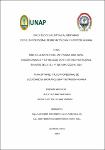Hábitos alimentarios, antiparasitario, nivel socioeconómico y su relación con el estado nutricional en niños de la I.E.I. N° 366 Rumo-Cocha-2019
Abstract
The present study aims to relate eating habits, ant parasitic, socioeconomic level and their relationship with the nutritional status of children of the I.E N°366 Rumo- Cocha, St. Clara road km2 carried out in 2019.The research has a quantitative approach, correlating o experimental type, with the pre-experimental design of pre-test and post-test with a single group and longitudinal cut, the total sample was 112 children. Anthropometric indicators (weighing, height, digital scale, height meter), biochemical analysis (hemoglobinometer), surveys of eating habits and socioeconomic level were evaluated and the data were processed in the SPPSS statistical program version 24 for Windows. According to the anthropometric indicator of weight/age the results show that 94.6% are in the normal range, 4.5% were overweight, 0.9 undernourished. According to height/age, 92.9% were in the normal range and 7.1% were underweight. The hemoglobin level indicates that 67.0% presented an average level, 23.2% mild anemia and 9.8% moderate anemia and concerning to eating habits 94.5% of the children have unhealthy habits, this is supported by our survey of the socioeconomic level of their parents where 50.9% have a medium level and 48.2% have a low level. Evidencing a significant relationship between eating habits with hemoglobin level and eating habits with height/age, antiparasitic before and after with. El presente estudio tiene por finalidad relacionar los hábitos alimentarios, antiparasitario, nivel socioeconómico y su relación con el estado nutricional de los niños de la I. E N°366 Rumo- Cocha, carretera St. Clara km2 realizado en el año 2019.La investigación tiene enfoque cuantitativo, correlacionar de tipo experimental, con diseño pre experimental de pre test y post test con un solo grupo y corte longitudinal, la muestra total fue de 112 niños. Se valoraron indicadores antropométricos (pesado, tallado, bascula digital, telemetro), análisis bioquímico (hemoglobinómetro), encuestas de hábitos alimentarios y nivel socioeconómico; y los datos fueron procesados en el programa estadístico SPPSS versión 24 para Windows. Los resultados obtenidos según el indicador antropométrico de peso/edad muestra que el 94.6% están en un rango normal, 4.5% tuvieron sobrepeso, 0,9 desnutridos. Según la talla/edad el 92.9% están en un rango normal y 7,1% talla baja. El nivel de hemoglobina indica que el 67.0% presento un nivel normal, el 23.2 % anemia leve y 9.8% anemia moderada y con respecto a los hábitos alimentarios el 94.5% de los niños y niña tienen hábitos no saludables esto se sustenta en base a nuestra encuesta de nivel socioeconómico de sus progenitores donde el 50.9% tiene un nivel medio y 48.2% tiene un nivel bajo. Evidenciamos una relación significativa con los hábitos alimentarios con el nivel de hemoglobina y también entre hábitos alimentarios con la talla/edad y con la toma del antiparasitario antes y después con el nivel de hemoglobina.
Collections
- Tesis [189]


